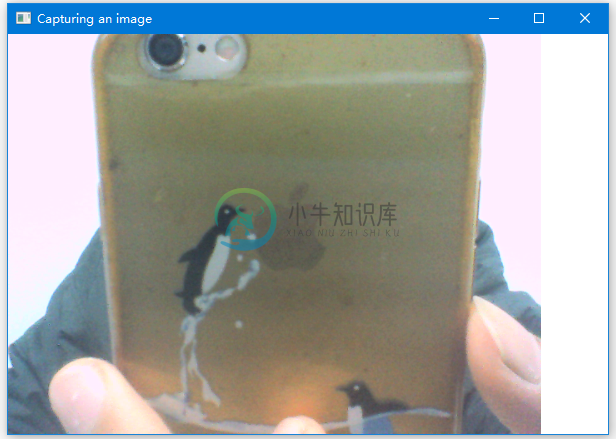OpenCV使用摄像头
精华
小牛编辑
173浏览
2023-03-14
在本章中,我们将学习如何使用OpenCV使用系统摄像头捕获帧。org.opencv.videoio包中的VideoCapture类包含使用相机捕获视频的类和方法。下面来一步一步学习如何捕捉帧 -
第1步:加载OpenCV本机库
在使用OpenCV库编写Java代码时,使用loadLibrary()加载OpenCV本地库。加载OpenCV本机库,如下所示 -
// Loading the core library
System.loadLibrary(Core.NATIVE_LIBRARY_NAME);
第2步:实例化视频捕获类
使用本教程前面提到的函数来实例化Mat类。
// Instantiating the VideoCapture class (camera:: 0)
VideoCapture capture = new VideoCapture(0);
第3步:阅取帧
可以使用VideoCapture类的read()方法从相机读取帧。此方法接受类Mat的对象来存储读取的帧。
// Reading the next video frame from the camera
Mat matrix = new Mat();
capture.read(matrix);
示例
以下程序演示如何使用相机捕捉帧并使用JavaFX窗口显示。它也保存捕获的帧。
package com.yiibai.cameraface;
import java.awt.image.BufferedImage;
import java.awt.image.DataBufferByte;
import java.awt.image.WritableRaster;
import java.io.FileNotFoundException;
import java.io.IOException;
import javafx.application.Application;
import javafx.embed.swing.SwingFXUtils;
import javafx.scene.Group;
import javafx.scene.Scene;
import javafx.scene.image.ImageView;
import javafx.scene.image.WritableImage;
import javafx.stage.Stage;
import org.opencv.core.Core;
import org.opencv.core.Mat;
import org.opencv.imgcodecs.Imgcodecs;
import org.opencv.videoio.VideoCapture;
public class CameraSnapshotJavaFX extends Application {
Mat matrix = null;
@Override
public void start(Stage stage) throws FileNotFoundException, IOException {
// Capturing the snapshot from the camera
CameraSnapshotJavaFX obj = new CameraSnapshotJavaFX();
WritableImage writableImage = obj.capureSnapShot();
// Saving the image
obj.saveImage();
// Setting the image view
ImageView imageView = new ImageView(writableImage);
// setting the fit height and width of the image view
imageView.setFitHeight(400);
imageView.setFitWidth(600);
// Setting the preserve ratio of the image view
imageView.setPreserveRatio(true);
// Creating a Group object
Group root = new Group(imageView);
// Creating a scene object
Scene scene = new Scene(root, 600, 400);
// Setting title to the Stage
stage.setTitle("Capturing an image");
// Adding scene to the stage
stage.setScene(scene);
// Displaying the contents of the stage
stage.show();
}
public WritableImage capureSnapShot() {
WritableImage WritableImage = null;
// Loading the OpenCV core library
System.loadLibrary( Core.NATIVE_LIBRARY_NAME );
// Instantiating the VideoCapture class (camera:: 0)
VideoCapture capture = new VideoCapture(0);
// Reading the next video frame from the camera
Mat matrix = new Mat();
capture.read(matrix);
// If camera is opened
if( capture.isOpened()) {
// If there is next video frame
if (capture.read(matrix)) {
// Creating BuffredImage from the matrix
BufferedImage image = new BufferedImage(matrix.width(),
matrix.height(), BufferedImage.TYPE_3BYTE_BGR);
WritableRaster raster = image.getRaster();
DataBufferByte dataBuffer = (DataBufferByte) raster.getDataBuffer();
byte[] data = dataBuffer.getData();
matrix.get(0, 0, data);
this.matrix = matrix;
// Creating the Writable Image
WritableImage = SwingFXUtils.toFXImage(image, null);
}
}
return WritableImage;
}
public void saveImage() {
// Saving the Image
String file = "F:/worksp/opencv/images/sanpshot.jpg";
// Instantiating the imgcodecs class
Imgcodecs imageCodecs = new Imgcodecs();
// Saving it again
imageCodecs.imwrite(file, matrix);
}
public static void main(String args[]) {
launch(args);
}
}
执行上面示例代码,得到以下结果 -
如果打开指定的路径,可以观察到保存一个.jpg文件(F:/worksp/opencv/images/sanpshot.jpg)。
